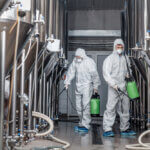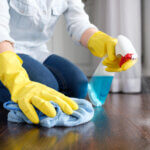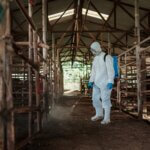Trichophyton mentagrophytes is a versatile dermatophyte fungus known for infecting the skin, hair, and nails of both humans and animals. It thrives in warm and moist environments like soil which is its natural habitat. Its transmission occurs majorly through direct contact with infected animals or indirectly via contaminated objects or surfaces which causes serious health threats for pet owners. Pets, especially those with outdoor access are at high risk of getting infected by this fungus making it a common issue for animals and their owners
Our pets are exposed to various health risks daily. Therefore, it is important to understand the safety precautions and care needed to create a healthy environment for both the pets and the owners. Among these health risk factors, fungal infections play a significant role particularly those caused by Trichophyton mentagrophytes. This article explains the nature of this fungus, its impact on pets, the importance of testing services for prevention and the importance of maintaining health and safety standards.
Trichophyton mentagrophytes Infections in Pets and Their Owners
Look for the Signs
In pets, infections may manifest as skin lesions, patchy fur loss, and evident itchiness that leads to scratching, biting, and further irritation. If not addressed immediately, these infections can become severe affecting the overall health and wellbeing of the pet.
Infection in human beings
Trichophyton mentagrophytes is a zoophilic fungus, which can be transmitted from infected animals to human beings. Pet owners handling infected animals or those coming into contact with contaminated objects are at risk of developing similar infections characterized by ring-shaped and itchy rashes on the skin.
Prevention and Control Measures against Trichophyton mentagrophytes
How to protect pets and their owners?
Preventive measures for controlling fungal infections are regular grooming, maintaining a clean living environment, and minimizing the pet’s exposure to areas susceptible to fungal growth. In addition, we should educate pet owners on fungal infections, the importance of early treatment, and how it can significantly reduce transmission.
How do disinfectants help in preventing Trichophyton Mentagrophytes infections?
Regular use of antifungal sanitizers and disinfectants on surfaces and pet accessories is necessary however not all products are equally effective against fungi. Thus it is important to test these disinfectants which have antifungal activity to validate their effectiveness.
Why testing services are needed?
For controlling and preventing infections caused by fungi such as Trichophyton mentagrophytes, testing services play an important role by ensuring the antifungal efficacy of disinfectants and sanitizers. Among the available test standards, the AOAC Use Dilution Test, EN 13624, and EN 17387 are known for their rigorous evaluation methods.
Knowing more about these tests is necessary for explaining their role in evaluating the efficiency of products such as disinfectants used to prevent the spread of infections. Manufacturers can provide certifications of these test standards to prove their product’s efficiency which would in turn be beneficial for marketing them.
The AOAC Use Dilution Test is an international standard for assessing the efficacy of disinfectants in killing specific microorganisms including pathogens like Trichophyton mentagrophytes. For this test, the fungus is cultivated under controlled conditions to generate a spore-bearing mycelium.
A series of dilutions of the test substance is prepared and maintained at a standardized temperature. Fungal spore suspension is then added to each dilution and incubated for a specific period of time. Post incubation, the viable fungal count remaining in each dilution is quantified to determine the maximum dilution of the test substance showing complete elimination of viable fungus.
EN 13624 is a European Standard for testing the bactericidal and yeasticidal and/or fungicidal activity of chemical disinfectants used in medical settings thus making it essential for evaluating products having antifungal activities.
This test provides evidence for the effectiveness of disinfectants used in areas prone to fungal growth and thus it also ensures that these products meet all the required properties to be used for controlling the spread of infections in areas of high risk such as the healthcare sector.
EN 17387 is a comprehensive standard test method that assesses the efficacy of chemical disinfectants and antiseptics against a wide spectrum of slime forming pathogens which include both bacteria and fungi. Essential for evaluating a product’s effectiveness against various pathogens such as Trichophyton mentagrophytes, this test provides critical data on the disinfectant’s range of activity thus aiding manufacturers and consumers in selecting suitable products for environments with high infection risks.
What is the significance of test standards?
The international standards provide a guideline for efficacy testing of antimicrobial products thus offering a quantifiable measure of a product’s ability to inhibit or kill microbes and their spores. This is very important for preventing the spread of infections between pets and from pets to humans and it also ensures a safe environment for interaction and cohabitation.
The test standards like AOAC Use Dilution Test, EN 13624 and EN 17387 serve as essential tools in the fight against infectious diseases including those caused by Trichophyton mentagrophytes fungal infections. To establish a product efficacy in rigorous standardized conditions, these tests:
Ensure Public Health and Safety: They confirm that disinfectants and sanitizers can effectively eliminate harmful pathogens reducing the risk of infection transmission.
Product Development: Manufacturers can refine and improve their products based on test results leading to more effective solutions for controlling infections.
Build Consumer Trust: Products verified by these tests are trusted by healthcare professionals, pet owners and the general public for their proven efficacy.
Conclusion
To prevent Trichophyton mentagrophytes infections and its impact on pets and their owners we must take effective control measures. By recognizing the importance of testing services and the role of dedicated organizations like MIS, we can ensure the safety and health of our pets and ourselves. As responsible pet owners and community members let’s prioritize the use of validated and effective products in our homes and environments.
At MIS, we recognize the serious nature of the challenge and stand ready to support businesses and clients in assessing the effectiveness of their products with fungicidal properties against Trichophyton mentagrophytes.
Our advanced testing laboratories are fully prepared to conduct antifungal/ fungicidal assessments with precision and reliability. Our leading team of microbiologists excels in performing detailed testing analysis and understanding the specific needs of our customers.
For any microbiology testing inquiries, please consult our experts today.









